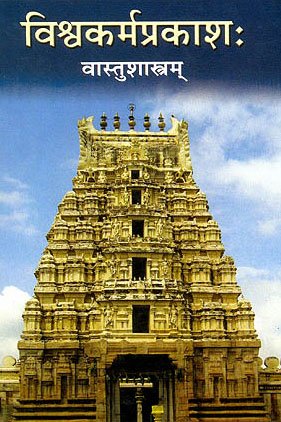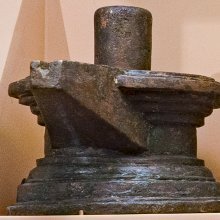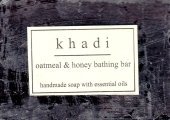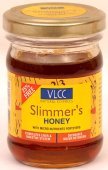Honey: 4 definitions
Introduction:
Honey means something in Hinduism, Sanskrit. If you want to know the exact meaning, history, etymology or English translation of this term then check out the descriptions on this page. Add your comment or reference to a book if you want to contribute to this summary article.
Images (photo gallery)
In Hinduism
Ayurveda (science of life)
Veterinary Medicine (The study and treatment of Animals)
Source: Asian Agri-History: Paśu Āyurvēda (Veterinary Medicine) in GaruḍapurāṇaHoney (in Sanskrit: madhu) is part of the diet in the treatment of horses, according to sections on the treatment of Horses (Gajāyurveda or Aśvāyurveda) in the Garuḍapurāṇa.—The diet also plays a role during the treatment because the food imparts a greater strength and vigour to the horses and acts as a general prophylactic against diseases. The following diets are mentioned for the horses in Garuḍapurāṇa, which are according to the doṣa: [...] The diet in pittaja-vikāra: In diseases due to the action of the deranged and aggravated Pitta, the diet should consist of a karṣa (12gm) weight of maṃsarasa (meat soup) mixed with madhu (honey), mudgarasa (green gram soup/ gravy) and ājya (clarified butter). [...]
Agriculture (Krishi) and Vrikshayurveda (study of Plant life)
Source: Asian Agri-History: Drumavichitrikaranam—The Ancient Approach to Plant MutagenesisHoney was used to produce Seedless Fruits: which was one of the technologies known to ancient Indian agriculturists, which presents a safe technology and methodology regarding organic agriculture, according to treatises (such as the Vrikshayurveda). One such technology was to produce seedless fruits: Seeds often impart a bitter taste, thereby causing an unpleasant experience while eating the fruit. Seeds also accelerate fruit deterioration. Hence seedless varieties of fruits have greater economic value. Use of Abrus precatorius (jequirity), Madhuca indica (butter tree), Saussurea lappa (costus), Glycyrrhiza glabra (liquorice), honey, sugar, and clarified butter is said to cause seedlessness.
Source: Shodhganga: Drumavichitrikarnam—Plant mutagenesis in ancient IndiaHoney (denoted by the Sanskrit term Madhu) is used in certain bio-organical recipes for plant mutagenesis, according to the Vṛkṣāyurveda by Sūrapāla (1000 CE): an encyclopedic work dealing with the study of trees and the principles of ancient Indian agriculture.—Accordingly, “If bulbs of various species of Nymphaea are uprooted tied together firmly with threads, smeared with melted butter and honey (madhu) and then planted they produce those respective species in bunches (on a single creeper). Similarly several wonders of transformation can be worked out by tying together the stems of Nerium indicum and those of various species of Punica granatum”.

Āyurveda (आयुर्वेद, ayurveda) is a branch of Indian science dealing with medicine, herbalism, taxology, anatomy, surgery, alchemy and related topics. Traditional practice of Āyurveda in ancient India dates back to at least the first millenium BC. Literature is commonly written in Sanskrit using various poetic metres.
Vastushastra (architecture)
Source: Shodhganga: Elements of Art and Architecture in the Trtiyakhanda of the Visnudharmottarapurana (vastu)Honey and Ghee are used to clean the axe during the cutting of trees for the purpose of gathering Material for the Construction of Temples, according to the Viṣṇudharmottarapurāṇa, an ancient Sanskrit text which (being encyclopedic in nature) deals with a variety of cultural topics such as arts, architecture, music, grammar and astronomy.—In the Viṣṇudharmottarapurāṇa, the architect is suggested to go to the forest to collect appropriate wood for temples in an auspicious day after taking advice from an astrologer. [...] At the time of Cutting the Trees one should clean the axe by smearing honey and ghee. After collecting the suitable wood from forest, the architect uses it according to his requirements and purposes. The eco-friendly suggestions of Viṣṇudharmottarapurāṇa are seen to protect the greenery and to balance a pollution free environment.

Vastushastra (वास्तुशास्त्र, vāstuśāstra) refers to the ancient Indian science (shastra) of architecture (vastu), dealing with topics such architecture, sculpture, town-building, fort building and various other constructions. Vastu also deals with the philosophy of the architectural relation with the cosmic universe.
See also (Relevant definitions)
Starts with: Honey bee, Honey flower, Honey flowers, Honey grass, Honey locust, Honey mesquite, Honey plant, Honey reed of the niger, Honey tree, Honey-bearing protea, Honey-berry, Honey-chuck, Honeylocust, Honeyshuck, Honeysuckle, Honeysuckle tree.
Full-text (+1140): Madhu, Kshaudra, Madhuparka, Makshika, Pancamrita, Makaranda, Madhvasava, Madhukara, Pauttika, Madhukulya, Yogavahin, Madhucyut, Bhramara, Madhavi, Saragha, Madhurasa, Madhava, Madhuvrata, Madhumastaka, Madhupa.
Relevant text
Search found 262 books and stories containing Honey; (plurals include: Honeys). You can also click to the full overview containing English textual excerpts. Below are direct links for the most relevant articles:
Sahitya-kaumudi by Baladeva Vidyabhushana (by Gaurapada Dāsa)
Text 10.141 < [Chapter 10 - Ornaments of Meaning]
Text 10.266 < [Chapter 10 - Ornaments of Meaning]
Text 10.147 < [Chapter 10 - Ornaments of Meaning]
Charaka Samhita (English translation) (by Shree Gulabkunverba Ayurvedic Society)
Chapter 18 - The therapeutics of Cough Disorder (kasa-cikitsa) < [Cikitsasthana (Cikitsa Sthana) — Section on Therapeutics]
Chapter 27j - The class of Sugarcane (Ikshu) < [Sutrasthana (Sutra Sthana) — General Principles]
Chapter 20 - The therapeutics of Vomiting (chardi-cikitsa) < [Cikitsasthana (Cikitsa Sthana) — Section on Therapeutics]
Chandogya Upanishad (Shankara Bhashya) (by Ganganatha Jha)
Section 3.1 (first khaṇḍa) (four texts) < [Chapter 3 - Third Adhyāya]
Section 3.2 (second khaṇḍa) (three texts) < [Chapter 3 - Third Adhyāya]
Section 3.4 (fourth khaṇḍa) (three texts) < [Chapter 3 - Third Adhyāya]
Rasa Jala Nidhi, vol 3: Metals, Gems and other substances (by Bhudeb Mookerjee)
Part 13 - Anupanas (accompaniments of iron) < [Chapter IV - Metals (4): Lauha (iron)]
Part 3 - Alcoholic liquors (2): Madhvi < [Chapter XXXIII - Spirituous liquors (Sandhana or Samdhana)]
Part 21 - Treatment of poison < [Chapter XXX - Visha (poisons)]
Atithi or Guest Reception (study) (by Sarika. P.)
Part 1 - Introduction to Madhuparka (ceremonial reception) < [Chapter 8 - Madhuparka]
Part 2 - References to Hospitality in the Kumārasaṃbhava < [Chapter 4 - Atithi-saparyā in Classical Sanskrit Literature]
Part 7 - Rules of food offering in Atithi-saparyā < [Chapter 9 - Atithi-saparyā in Dharmaśāstra Literature]
The Agni Purana (by N. Gangadharan)
Related products
(+239 more products available)







